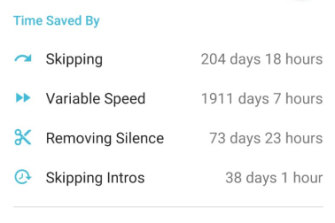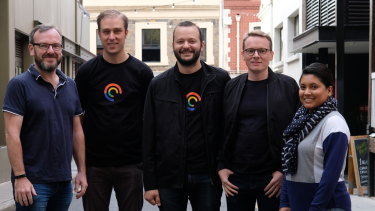With an exponentially growing amount of new content to watch and listen to, but the same number of hours in the day in which to consume it, people are increasingly living in fast forward by speeding up their stories, entertainment and information.
Variable speed isn't a new concept. Way back in 1999 Microsoft research explored the possibility of digital "time compression" systems, which automatically removed silences and sped up media while pitching the audio down to avoid a "chipmunk" effect and keep speech intelligible.
In fact the study of time compressed audio and its effect on comprehension had begun some fifty years earlier, but it wasn't until the advent of online media that techniques became accessible to regular consumers.
These days Microsoft's old findings — that given the choice people prefer to speed up to 1.3x or 1.5x, to bring spoken dialogue speed in line with regular reading speed — seem to have been borne out. The big difference is that the tools available now make it easy for listeners to skip, speed and scrub at will, giving them total control and making listening more like reading a book.
All the most popular services for listening to podcasts or audiobooks, like Pocket Casts or Audible respectively, have the baked in ability to raise the speed while maintaining the pitch. Pocket Casts even has an option for users to check their own stats and see how much time they've saved by speeding things up and removing silences.
J Michael Jones, an economist based in the US, subscribes to more than 1400 podcasts. He says he listens an average of 12 hours a day. But thanks to the variable speed and ability to skip silences, that's potentially more than 36 hours of content.
Mr Jones’ Pocket Casts ‘time saved’ stats.
"I find that news, true crime and historical podcasts are easily understood at 3x," he says, noting that he moves down to 2x for economics and business podcasts.
"However some podcasts, such as educational lectures or those focused on music, do not lend themselves to higher speeds."
Since March 2015 Mr Jones has listened via Pocket Casts for the equivalent of 711 days and 10 hours of real time, but the variable speed option has actually let him cram in more than 2500 days of content (i.e. it has saved him 1911 days, or more than five years).
He says he can still consume and enjoy media at regular speed, but it can be weird.
"There are times when I hear shows on the radio that I subscribe to as podcasts, and I think to myself, 'Are they drunk? They sound like they're trying to speak underwater!"
The Australian founder of Pocket Casts, Shifty Jelly's Russel Ivanovic, says users have cumulatively saved more than 22 centuries worth of time using the variable speed feature since stat-tracking started in 2015, and that's only counting the 60 per cent of users who are actually signed in.
Pocket Casts founder Russell Ivanovic, centre, and his crew.
“The reason we added [variable speed] that was a lot of people were asking for it and we started to get a lot of requests," Mr Ivanovic says.
“We’ve even had people ask us for four and five times the speed. Three is as fast as we do it. I don’t think you can understand anything past three speed, but most of them seem convinced they can."
He thought what drew people to the feature varied based on personal preference.
"Some people find listening on one speed they get frustrated. Like: ‘I’m sitting here, knowing I could be listening to more in a shorter period of time’," he says.
"In Australia we’re also known for talking quite fast, so being able to bump the speed a little bit might be a way of getting [slower-speaking American podcasts] to match what we’re used to."
But it isn't just audio being consumed at super speeds; people are increasingly consuming video this way as well. YouTube natively supports increasing the speed up to 2x, and a popular Chrome extension (with more than 800 thousand users) gives the ability to control the speed of any HTML5 video on the web.
YouTube can easily be sped up by two times, but if you want it faster you’ll need to seek out other tools.
Sydney video producer Aidan Molins now watches "almost all" non-music YouTube videos at double speed.
"I realised a lot of the things I was watching on YouTube were just guys talking for 15 minutes," he says.
“Most of the content on YouTube now is quite long and often padded out to get to the 10 minute mark, so double speed is usually good. The only time that I will watch something at normal speed now is if it’s actually scripted or well edited.”
He has not yet been converted to speeding up podcasts, however.
“When I’m listening to podcasts it’s because there’s something else I’m doing like cooking or commuting or household chores, so it would be too much to have it sped up, but if I was just sitting down in an armchair to listen to a podcast I’d do it."
Source: Read Full Article


